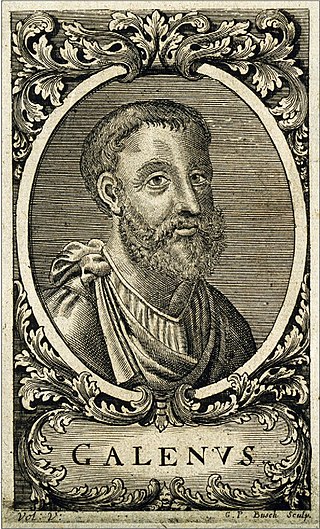
Aelius Galenus or Claudius Galenus, often Anglicized as Galen or Galen of Pergamon, was a Roman Greek physician, surgeon and philosopher. Considered to be one of the most accomplished of all medical researchers of antiquity, Galen influenced the development of various scientific disciplines, including anatomy, physiology, pathology, pharmacology, and neurology, as well as philosophy and logic.

Andreas Vesalius was a 16th-century anatomist, physician, and author of one of the most influential books on human anatomy, De Humani Corporis Fabrica Libri Septem, a major advance over the long-dominant work of Galen. Vesalius is often referred to as the founder of modern human anatomy. He was born in Brussels, which was then part of the Habsburg Netherlands. He was a professor at the University of Padua (1537–1542) and later became Imperial physician at the court of Emperor Charles V.
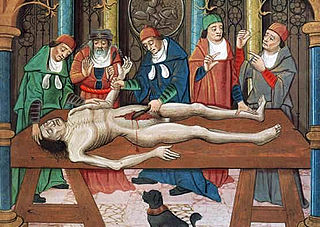
The history of anatomy extends from the earliest examinations of sacrificial victims to the sophisticated analyses of the body performed by modern anatomists and scientists. Written descriptions of human organs and parts can be traced back thousands of years to ancient Egyptian papyri, where attention to the body was necessitated by their highly elaborate burial practices.
The ossicles are three bones in either middle ear that are among the smallest bones in the human body. They serve to transmit sounds from the air to the fluid-filled labyrinth (cochlea). The absence of the auditory ossicles would constitute a moderate-to-severe hearing loss. The term "ossicle" literally means "tiny bone". Though the term may refer to any small bone throughout the body, it typically refers to the malleus, incus, and stapes of the middle ear.

Herophilos, sometimes Latinised Herophilus, was a Greek physician regarded as one of the earliest anatomists. Born in Chalcedon, he spent the majority of his life in Alexandria. He was the first scientist to systematically perform scientific dissections of human cadavers. He recorded his findings in over nine works, which are now all lost. The early Christian author Tertullian states that Herophilos vivisected at least 600 live prisoners; however, this account has been disputed by many historians. He is often seen as the father of anatomy.

Jacques Dubois was a French anatomist. Dubois was the first to describe venous valves, although their function was later discovered by William Harvey. He was the brother of Franciscus Sylvius Ambianus, professor of humanities at the Collège de Tournai, Paris.

Comparative anatomy is the study of similarities and differences in the anatomy of different species. It is closely related to evolutionary biology and phylogeny.
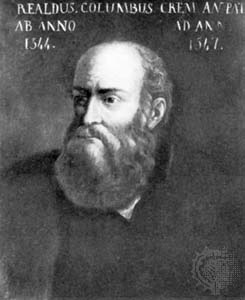
Matteo Realdo Colombo was an Italian professor of anatomy and a surgeon at the University of Padua between 1544 and 1559.
Neurophysiology is a branch of physiology and neuroscience that studies nervous system function rather than nervous system architecture. This area aids in the diagnosis and monitoring of neurological diseases. Historically, it has been dominated by electrophysiology—the electrical recording of neural activity ranging from the molar to the cellular, such as patch clamp, voltage clamp, extracellular single-unit recording and recording of local field potentials. However, since the neurone is an electrochemical machine, it is difficult to isolate electrical events from the metabolic and molecular processes that cause them. Thus, neurophysiologists currently utilise tools from chemistry, physics, and molecular biology to examine brain activity.
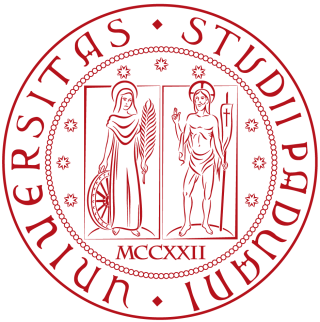
The University of Padua is an Italian university located in the city of Padua, region of Veneto, northern Italy. The University of Padua was founded in 1222 by a group of students and teachers from Bologna. Padua is the second-oldest university in Italy and the world's fifth-oldest surviving university. In 2010, the university had approximately 65,000 students.

Moulage is the art of applying mock injuries for the purpose of training emergency response teams and other medical and military personnel. Moulage may be as simple as applying pre-made rubber or latex "wounds" to a healthy "patient's" limbs, chest, head, etc., or as complex as using makeup and theatre techniques to provide elements of realism to the training simulation. The practice dates to at least the Renaissance, when wax figures were used for this purpose.

Lina Solomonovna Stern was a Soviet biochemist, physiologist and humanist whose medical discoveries saved thousands of lives at the fronts of World War II. She is best known for her pioneering work on the blood–brain barrier, which she described as hemato-encephalic barrier in 1921.

De Humani Corporis Fabrica Libri Septem is a set of books on human anatomy written by Andreas Vesalius (1514–1564) and published in 1543. It was a major advance in the history of anatomy over the long-dominant work of Galen, and presented itself as such.
The study of neurology and neurosurgery dates back to prehistoric times, but the academic disciplines did not begin until the 16th century. From an observational science they developed a systematic way of approaching the nervous system and possible interventions in neurological disease.
From the ancient Egyptian mummifications to 18th-century scientific research on "globules" and neurons, there is evidence of neuroscience practice throughout the early periods of history. The early civilizations lacked adequate means to obtain knowledge about the human brain. Their assumptions about the inner workings of the mind, therefore, were not accurate. Early views on the function of the brain regarded it to be a form of "cranial stuffing" of sorts. In ancient Egypt, from the late Middle Kingdom onwards, in preparation for mummification, the brain was regularly removed, for it was the heart that was assumed to be the seat of intelligence. According to Herodotus, during the first step of mummification: "The most perfect practice is to extract as much of the brain as possible with an iron hook, and what the hook cannot reach is mixed with drugs." Over the next five thousand years, this view came to be reversed; the brain is now known to be the seat of intelligence, although colloquial variations of the former remain as in "memorizing something by heart".

Angelo Mosso is the 19th century Italian physiologist who invented the first neuroimaging technique ever, known as 'human circulation balance'.
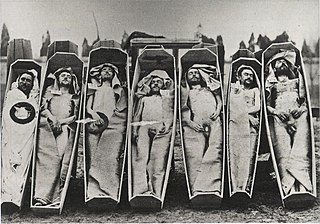
A cadaver or corpse is a dead human body. Cadavers are used by medical students, physicians and other scientists to study anatomy, identify disease sites, determine causes of death, and provide tissue to repair a defect in a living human being. Students in medical school study and dissect cadavers as a part of their education. Others who study cadavers include archaeologists and arts students. In addition, a cadaver may be used in the development and evaluation of surgical instruments.
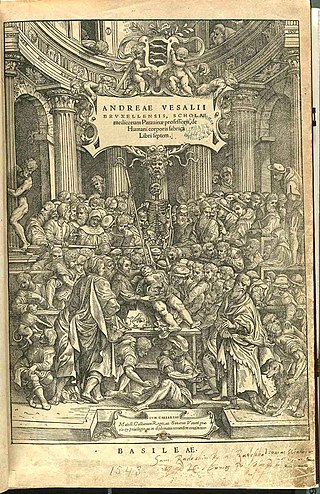
The Medical Renaissance, from around 1400 to 1700 CE, was a period of progress in European medical knowledge, with renewed interest in the ideas of the ancient Greek and Roman civilizations along with Arabic-Persian medicine, following the translation into Latin of many works from these societies. Medical discoveries during the Medical Renaissance are credited with paving the way for modern medicine.
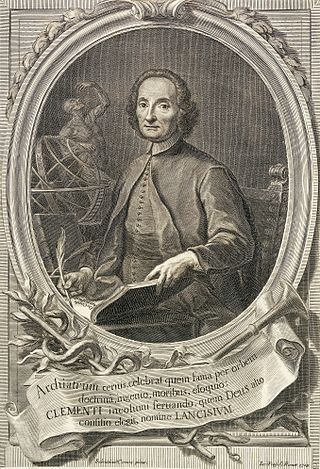
Giovanni Maria Lancisi was an Italian physician, epidemiologist and anatomist who made a correlation between the presence of mosquitoes and the prevalence of malaria. He was also known for his studies about cardiovascular diseases, an examination of the corpus callosum of the brain, and is remembered in the eponymous Lancisi's sign. He also studied rinderpest during an outbreak of the disease in Europe.

Stefano Sandrone (1988) is an Italian neuroscientist, an educationalist and a Senior Teaching Fellow at Imperial College London.
















